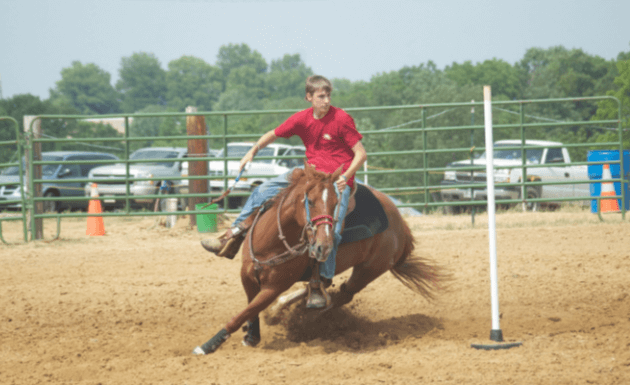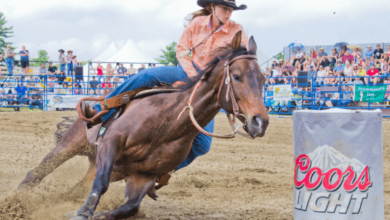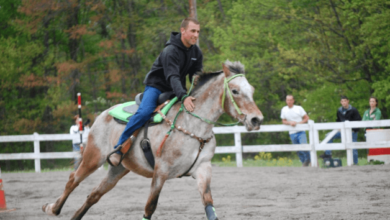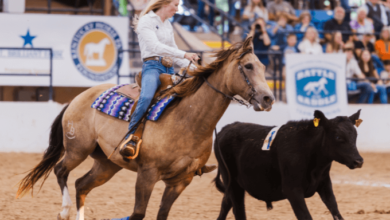How can I teach my horse pole bending?

Teaching a horse pole bending is an exciting journey that combines speed, agility, and precision. Pole bending is a timed event in rodeo competitions where horses weave between six poles placed in a straight line. The horse must complete the pattern as quickly as possible while maintaining tight turns and a smooth flow. For many riders, pole bending offers a thrilling test of their horse’s ability to maneuver swiftly while staying focused on the rider’s commands.
Training a horse for pole bending requires patience, consistency, and a systematic approach. By breaking down the training process into manageable steps and focusing on building a strong foundation, you can develop a confident, responsive, and agile pole bending horse.
Selecting the Right Horse for Pole Bending
Not every horse is naturally suited to pole bending, but with proper training, many can become competitive. However, certain physical and mental traits will give some horses an edge in this high-energy event.
Physical Attributes
Horses with a more compact build tend to excel at pole bending because of their ability to make quick, sharp turns. Look for a horse that has a good balance between speed and agility. Horses that are light on their feet, with strong hindquarters and good overall muscle tone, are generally better equipped to handle the fast, tight maneuvers required in pole bending.
Mental Disposition
The mental makeup of a horse is just as important as its physical attributes. Horses that are willing, focused, and responsive to cues often excel in pole bending. Your horse should have the ability to handle the intensity of speed work without becoming overly anxious or excited. A calm yet energetic horse will respond better to training and be more reliable in competition.
Building a Solid Foundation
Before introducing poles, it’s essential to ensure that your horse has a solid foundation in basic training. Your horse should be responsive to your seat, legs, and reins, and should understand how to move forward, stop, and turn on command. Having control over your horse’s movement at various speeds is a fundamental step toward successful pole bending.
Groundwork and Lungeing
Groundwork is key in developing respect, trust, and responsiveness between you and your horse. Work on exercises that teach your horse to move forward and yield to pressure, as these skills will be necessary when navigating the poles.
Lungeing is another excellent way to build your horse’s physical fitness and help them learn to balance themselves while moving at different speeds. Lungeing your horse in circles and serpentines will improve its suppleness and coordination, both of which are crucial for pole bending.
Suppleness and Flexibility
One of the most important aspects of pole bending is teaching your horse to be supple and flexible through their neck and body. Practice exercises like circles, figure-eights, and serpentines to encourage your horse to bend and flex properly. The more flexible your horse is, the easier it will be for them to make the tight turns required in pole bending.
Introducing the Poles
Once your horse has a solid foundation, it’s time to introduce them to the poles. Start slowly to ensure your horse remains relaxed and confident throughout the process.
Setting Up the Pattern
The pole bending pattern consists of six poles spaced 21 feet apart. The rider weaves the horse between the poles in a serpentine pattern, completing a run up and back. To begin training, you can start with fewer poles, such as three, and gradually work up to the full six poles once your horse is comfortable with the pattern.
Walking Through the Pattern
Begin by walking your horse through the pole pattern. This slow introduction helps your horse understand the path they’ll need to follow. Focus on keeping your horse relaxed and responsive to your aids as they navigate the poles. Encourage them to bend their body around each pole, using your legs and reins to guide them.
Take your time in this stage—rushing can lead to confusion and frustration for the horse. Allow your horse to walk through the poles multiple times until they seem comfortable and understand the path they need to follow.
Progressing to Trotting and Cantering
Once your horse is comfortable walking through the poles, it’s time to increase the speed by introducing the trot and eventually the canter.
Trotting Through the Poles
Trotting through the poles is an excellent way to teach your horse the precision and coordination needed for pole bending. As you trot, focus on maintaining control and keeping your horse balanced. Use your reins and legs to guide your horse’s movements, making sure they remain supple and responsive as they weave through the poles.
At this stage, don’t worry about speed—your main goal is to ensure your horse is bending properly around each pole and not cutting corners. Work on keeping the turns tight and clean without rushing through the pattern.
Cantering Through the Poles
Once your horse has mastered trotting through the poles with precision, you can begin working on cantering. Cantering adds another level of difficulty, as it requires the horse to navigate the poles while maintaining a higher speed. Start by cantering in a straight line to build your horse’s confidence at this gait before attempting to weave through the poles.
When you first attempt to canter through the poles, break the pattern down into smaller sections. For example, canter straight up to the first pole, slow down to a trot to weave through, and then pick up the canter again after the last pole. This method allows your horse to gradually adjust to the higher speed without becoming overwhelmed.
As your horse becomes more comfortable, you can attempt to canter through the entire pattern. Keep your cues clear and concise, and ensure your horse remains responsive to your aids throughout.
Mastering the Turn
Tight, controlled turns are the essence of successful pole bending. Teaching your horse to turn tightly around the poles without losing balance or momentum is crucial.
Teaching the Horse to Pivot
One effective method for teaching tight turns is to practice pivots or rollbacks. Start by asking your horse to turn sharply in a controlled space, such as in the corner of a ring or arena. Use your inside leg to push your horse into the turn, and your outside rein to guide their head and neck. The goal is to teach your horse to pivot around their hindquarters, which will help them navigate the poles more efficiently.
Practice these turns at a walk and trot before introducing them into the pole bending pattern. The tighter and more controlled your horse’s turns are, the more time you’ll save during the pattern.
Balancing Speed and Precision
One of the most challenging aspects of pole bending is balancing speed with precision. While it’s tempting to push for speed early on, rushing your horse can lead to sloppy turns and mistakes. Focus first on accuracy, ensuring your horse is bending properly and maintaining balance throughout the pattern. Gradually increase the speed as your horse becomes more confident and capable.
Using Body Language and Cues
Pole bending requires excellent communication between horse and rider. Your horse should respond immediately to your body language and cues, allowing you to make quick adjustments as you navigate the poles.
Leg and Rein Aids
Your legs and reins are essential tools for guiding your horse through the poles. Use your inside leg to ask your horse to bend around each pole, while using your outside rein to guide their head and neck. It’s important to remain soft in your hands and avoid pulling on the reins, as this can cause your horse to brace or become stiff through the turns.
Work on developing a strong connection with your horse through your seat and legs, as this will allow you to make more subtle adjustments during the run. Practice half-halts to help your horse stay balanced and collected during turns, especially when transitioning between poles.
Developing Rhythm and Timing
Rhythm and timing are critical in pole bending. As you guide your horse through the pattern, focus on maintaining a consistent pace and staying in tune with your horse’s movements. It’s important to anticipate each turn and prepare your horse before reaching the next pole.
Developing this rhythm comes with practice and experience. The more you work with your horse, the more you’ll learn to feel when they need a slight adjustment or encouragement to stay balanced.
Building Speed and Stamina
Pole bending is a high-speed event, so building your horse’s stamina and conditioning is an important part of the training process.
Interval Training
One effective way to build your horse’s stamina for pole bending is through interval training. Alternate between periods of fast work, such as cantering or galloping, and slower work, like walking or trotting. This type of training will help your horse build the endurance needed to handle the quick bursts of speed in pole bending.
Long-Trotting
Long-trotting is another excellent conditioning exercise that can improve your horse’s cardiovascular fitness and overall strength. This exercise involves trotting your horse for extended periods, focusing on maintaining a steady, rhythmic pace. Long-trotting helps to develop your horse’s muscles and stamina, making them better equipped to handle the physical demands of pole bending.
Troubleshooting Common Problems
Even with the best training, you may encounter challenges along the way. Here are some common issues in pole bending and how to address them:
- Cutting too close to the poles: If your horse is cutting too close to the poles, practice wider turns during your training sessions. This will help your horse understand the importance of maintaining space between their body and the poles.
- Rushing through the pattern: Horses that rush through the pattern may need more work on controlling their speed. Practice slowing down the pattern at a trot or even a walk to reinforce precision and control before adding speed.
- Lack of flexibility in turns: If your horse struggles with bending around the poles, spend more time working on flexibility exercises, such as circles and serpentines, to improve their suppleness.
Preparing for Competition
Once your horse has mastered the basics of pole bending, it’s time to prepare for competition. Begin by practicing the full pole bending pattern regularly, incorporating speed work to help your horse adjust to the pace of a real run.
Simulating Competition Conditions
To get your horse accustomed to the pressure of competition, practice under simulated show conditions. This could include riding in different arenas, using different poles, or having other horses around. The more familiar your horse is with various settings, the more confident they’ll be on competition day.
Conclusion
Teaching your horse pole bending is a rewarding process that requires patience, skill, and consistent training. By building a solid foundation, focusing on flexibility and precision, and gradually increasing speed, you can develop a horse that is both agile and responsive in the pole bending arena. Remember, success in pole bending is about balancing speed with control—take the time to train your horse thoroughly, and you’ll see the results in competition.



